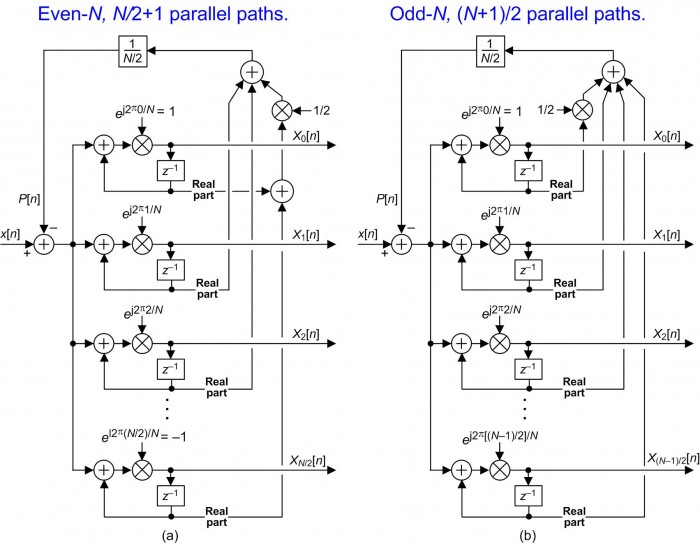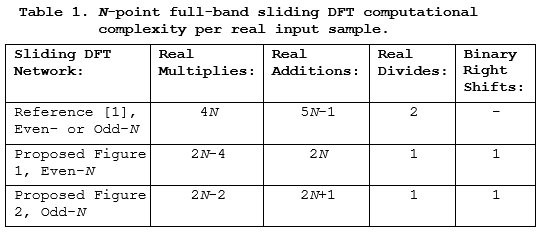An Efficient Full-Band Sliding DFT Spectrum Analyzer
In this blog I present two computationally efficient full-band discrete Fourier transform (DFT) networks that compute the 0th bin and all the positive-frequency bin outputs for an N-point DFT in real-time on a sample-by-sample basis.
An Even-N Spectrum Analyzer
The full-band sliding DFT (SDFT) spectrum analyzer network, where the DFT size N is an even integer, is shown in Figure 1(a). The x[n] input sequence is restricted to be real-only valued samples. Notice that the only real parts of the delay elements’ complex-valued outputs are used to compute the feedback P[n] samples.

The Figure 1(a) network’s complex coefficients are defined by $e^{j2{\pi}k/N}$ where integer k defines the DFT bin index and is in the range 0 ≤ k ≤ N/2. This even-N network has N/2+1 parallel paths that compute the complex-valued X0, X1, X2,..., XN/2 DFT bin output samples. The multiply by 1/2 can be implemented with a simple binary right shift by one bit.
The Figure 1(a) even-N network was inspired by the Figure 4 network in Reference [1]. However, for real-valued input samples I’ve simplified the Reference [1] network (which has N parallel paths) and reduced its computational complexity to develop the above proposed Figure 1(a) network.
An Odd-N Spectrum Analyzer
To compute real-time positive-frequency odd-N-point DFT spectral samples we use the network shown in Figure 1(b). This odd-N network has (N+1)/2 parallel paths that compute the X0, X1, X2,..., X(N-1)/2 DFT bin output samples. Again the x[n] input sequence is restricted to be real-only valued samples. The Figure 1(b) network’s complex coefficients are defined by $e^{j2{\pi}k/N}$ where integer k is 0 ≤ k ≤ (N-1)/2.
Two surprising properties of both Figure 1 networks are: 1) although they use recursive complex multiplications the networks are guaranteed stable, and 2) the networks compute sliding DFT samples without a comb delay-line section required by traditional sliding DFT networks! (The Reference [1] network also has those two noteworthy properties.)
Implementation
Both Figure 1 networks are implemented as follows:
1) Set the outputs of the delay elements and the P[0] feedback sample to zero.
2) Accept the first x[0] input sample and compute the Xk[0] output samples for each parallel path.
3) Shift the data through the delay elements and compute the P[1] feedback sample.
4) Accept the second input sample and compute the Xk[1] output samples for each parallel path.
5) Shift the data through the delay elements and compute the new P[2] feedback sample.
6) And so on.
Computational Complexity Comparison
In case you’re interested in the computational workload of the Reference [1] network and our two proposed Figure 1 networks, have a look at Table 1.

Conclusion
I presented computationally efficient full-band sliding DFT networks that compute the 0th bin and all the positive-frequency DFT bin outputs for both even- and odd-N-point DFTs in real-time on a sample-by-sample basis. (No taxpayer money was used and no animals were injured in the creation of this blog.)

References
[1] Z. Kollar, F. Plesnik, and S. Trumpf, “Observer-Based Recursive Sliding Discrete Fourier Transform,” IEEE Signal Proc. Mag., Vol. 35, No. 6, pp. 100-106, Nov. 2018.
- Comments
- Write a Comment Select to add a comment
I notice this is posted on April 1. Am I foolish to read it?
John P

Hi JProvidenza.
Ah ha. Such an interesting question. The answer is no, you would not be foolish to read it. (Perhaps I should have paid more attention to the date and posted this blog on April 2nd.)
Rick -
I couldn't resist the comment - it was too sweet a date!
Thanks for all your great posts. I have a couple of your books that I've used for study - my background is not DSP, but it's great to stretch my brain on topics I was not introduced to in college decades ago.
John P
Rick -
Could you add a little info on how to interpret the output?
Thanks!
John P

Hi JProvidenza.
Well, ...the traditional sliding DFT, shown in the following diagram, is used to compute the real-time (one output sample for each new input sample) kth bin output of a N-point DFT. (The X_k[n] output is the kth bin output of a N-point DFT for the current input sample and the previous N-1 input samples.) The typical application of the traditional sliding DFT is to detect the presence, or absence, of spectral energy centered at the kth bin of an N-point DFT in real time.

If you wanted to simultaneously compute the k = 3, k = 5, and k = 7 bins’ outputs you would use the following network.

For real-valued x[n] input sequences, my blog’s Figure 1 networks are used to compute the 0th bin and all the positive-frequency bin outputs of an N-point DFT in real-time (on a sample-by-sample basis). Notice in my blog’s Figure 1 that, unlike the traditional sliding DFT, no N-length delay line stage is needed.
I hope what I've written here makes sense.
Hi Rick,
I am not sure if my question is related to this exact article.
Could the sliding DFT be used to extract different bins of an OFDM signal which is not really like a sine wave. Also is it applicable on parallel samples?
Regards,
Tushar

Hello tushar_tyagi90
This blog presents an efficient way to compute the N complex output bin samples of an N-point DFT in real time. By “real time” I mean that that for each data input sample all N DFT bin complex spectral sample values are computed. The output samples of this scheme are not valid until the Nth input sample has been applied to the network. [The traditional DFT (or radix-2 FFT) provides outputs only for every N input samples--it’s not “real-time”.] The networks in this blog's Figure 1 are only valid for real-valued input samples.
A sliding DFT network, on the other hand, computes a single complex output bin spectral sample of an N-point DFT in real time (one complex output spectral sample for each input sample).
I have no experience in OFDM processing, but if your OFDM processing requires you to compute all N output spectral samples of an N-point DFT in real time then one of the networks in this blog’s Figure 1 should achieve your goal.
If your OFDM processing requires you to compute, say 8, real time N-point DFT spectral samples (where N is greater than 8) then you merely need to implement 8 sliding DFT networks. That is, one comb section driving 8 separate resonator sections.
I must tell you, “traditional” sliding DFT networks can experience long-term stability problems. Several guaranteed-stable sliding DFT networks have been proposed in the literature but they’re more computationally intensive than the traditional sliding DFT. Last year I developed a guaranteed-stable sliding DFT network that is significantly more computationally efficient than the previously proposed guaranteed-stable sliding DFT networks.
My “new and improved” guaranteed-stable sliding DFT is described at:
"Improvements to the Sliding DFT Algorithm", DSP Tips & Tricks column, IEEE Signal Processing Magazine, Vol. 38, No. 4, July 2021.
I intend to write a blog at this dsprelated.com web site describing my new and improved sliding DFT network as soon as I have the time.
tushar_tyagi90, if you have any further questions for me please let me know.
To post reply to a comment, click on the 'reply' button attached to each comment. To post a new comment (not a reply to a comment) check out the 'Write a Comment' tab at the top of the comments.
Please login (on the right) if you already have an account on this platform.
Otherwise, please use this form to register (free) an join one of the largest online community for Electrical/Embedded/DSP/FPGA/ML engineers:























